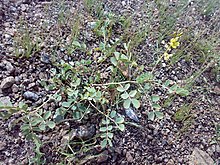Cassia obovata
| Senna italica | |
|---|---|
 |
|
| Senegal senna with flower | |
| Scientific classification | |
| Kingdom: | Plantae |
| (unranked): | Angiosperms |
| (unranked): | Eudicots |
| (unranked): | Rosids |
| Order: | Fabales |
| Family: | Fabaceae |
| Subfamily: | Caesalpinioideae |
| Tribe: | Cassieae |
| Subtribe: | Cassiinae |
| Genus: | Senna |
| Species: | S. italica |
| Binomial name | |
|
Senna italica Mill. |
|
| Subspecies | |
|
S. i. arachoides |
|
| Synonyms | |
|
Cassia italica (Mill.) Spreng. (1800) |
|
S. i. arachoides
S. i. italica
S. i. micrantha
Cassia italica (Mill.) Spreng. (1800)
Cassia obovata Collad. (1816)
Senna italica, the Port Royal senna,Italian senna, or Senegal senna is a legume tree in the genus Senna. It is recognized by many other common names based on the regions it grows in. In India, it is used to produce a powder used to treat hair which is known as “neutral henna”. Senegal senna is easily distinguishable through its many distinctive features. There are 3 subspecies of this plant based on the size of the inflorescence and the length of the petiole. The subspecies are italica, micrantha, and arachoides. In many regions, this plant is cultivated commercially and medicinally.
Individuals of this species are deciduous, perennial herbs, and shrubs up to 60 cm tall. The plant is woody throughout. Taproots are present in this plant. Stems are solid, usually less than 2 m tall. These stems or young twigs are glabrous or sparsely glabrous and sparsely to densely hairy. This species has compound leaves with pinnate veination. There are approximately 4-6 leaflets per leaf, which are arranged spirally and alternately. The leaflets are elliptical, and shortly hairy on both sides. There is a small reddish gland between each leaflet pair on the rhachis of arachoides subspecies. The stipules are usually have lanceolate-triangular shape. They are approximately 3–9 mm long and early spreading –deflexed.
Flowering usually takes place during rainy season, but flowers can appear throughout the year in moist conditions. Senna italica is usually propagated by seeds. Treating the seed by abrasion improves germination. Flowers of Senna italica, are actinomorphic and the inflorescence takes the form of axillary racemes, which are about 2–25 cm long. Petals of these flowers are usually yellow or orange in color, up to 13 mm long and are of obovate shape. Rhombic to ovate bracts are conspicuously present, but very small in size (up to 5mm long). The flower of Senegal senna is bisexual, zygomorphic and 5-merous. It usually has 10 stamens (lower 2 are the largest; 5 are medium-sized; 3 are short and sterile), Style up to 6 mm long and a superior ovary with short and stiff hair. Senegal senna has freely dehiscent fruits. Fruits are oblong or ellipsoidal; they are strongly curved, falcate, bent or lunate shaped. The fruit may contain as many as 11 seeds. The seeds have elliptical line or depression and are wrinkled or rugose. Seeds are usually of olive, green or black color.
Senegal senna is native to African countries from Cape Verde east to Somalia and south to South Africa. It is also native to Asia, from the Middle East to Iran, Iraq, Pakistan and India to Sri Lanka. Later, this plant has been introduced to Caribbean and Venezuela. This plant is also introduced to the USA and is currently located at New York Botanical Garden. The subspecies italica is often found in West Africa, North Africa, Sudan, the Horn of Africa and from Yemen to Northwest India. But it is naturalized in some parts of South Africa. Subspecies micrantha is mostly seen from Southern Ethiopia and Somalia southwards to Namibia, Botswana, Zimbabwe and Mozambique. Micrantha has been introduced to India too. Arachoides are limited to Namibia, Botswana and South Africa.
...
Wikipedia
